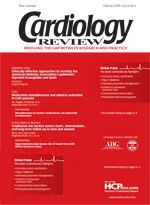Publication
Article
Cardiology Review® Online
Primary coronary intervention for acute myocardial infarction
Primary coronary intervention for acute myocardial infarction
Primary coronary intervention for acute myocardial infarction is rapidly becoming the most preferred way of treating this life-threatening acute event. Boston has a demonstration project1 that has been ongoing for several years in which emergency calls for ST elevation acute myocardial infarction (STEMI) are triaged to hospitals that perform acute coronary intervention around the clock within predetermined time intervals and with predetermined outcomes. New York State is contemplating initiating a similar project. All of this
is very exciting for someone like
me because I have believed in this procedure for acute infarct patients since 1984. It only makes sense,
however, if outcomes are as good as or better than those obtained with thrombolytic agents.
The study by Henriques and colleagues (page 27) from the Netherlands has identified from their large experience with acute infarct intervention that there were circadian differences in outcome in their cohort of acute infarct patients. Is this because there are circadian differences in the patient population, or differences in the performance of the procedure? An analysis of their 1,702 patients treated between 1994 and 2000 showed that 860 patients were diagnosed either in the ambulance or at another hospital, while the rest (842) were diagnosed in the interventional hospital.
The majority of patients (53%) were treated during normal working hours (8:00 am to 6:00 pm). There were no differences in clinical variables and antegrade flow of the infarct-related artery between the two groups (on-hours and off-hours). There was a significant difference, however, in the number of failed procedures and in the 30-day mortality rate between successful and failed procedures. There was a significant 30-day mortality difference between those patients treated during regular hours (8:00 am to 6:00 pm) and those patients treated after hours (6:00 pm to 8:00 am).
Although there have been reports of more congestive heart failure in nighttime infarcts,2 there was no difference in Killip class between these two groups. Other circadian differences have been documented in the literature for variables that might influence intervention outcome, such as platelet aggregation, levels of tissue plasminogen activator, etc.3 The literature has also described a circadian variation in thrombolytic therapy.4 The authors verified that door-to-balloon times for both groups were the same.
Conclusions
In summary, although the authors adequately documented the difference in outcomes between these two groups of patients, they were at a loss, as am I, to adequately explain the reasons for this difference. Naturally, none of us are willing to believe that the quality of care is “different” after regular working hours. n
